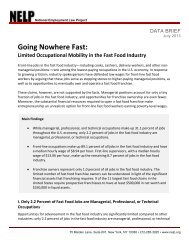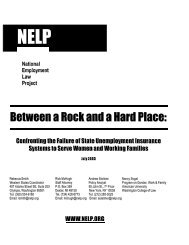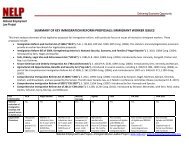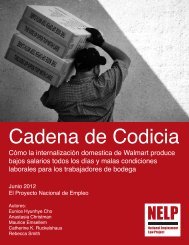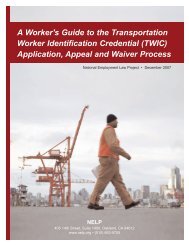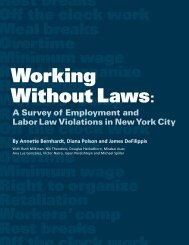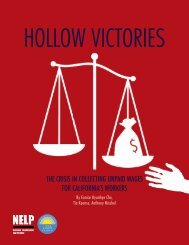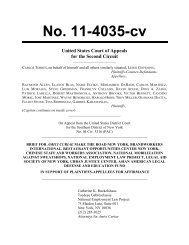National Employment Law Project
National Employment Law Project
National Employment Law Project
You also want an ePaper? Increase the reach of your titles
YUMPU automatically turns print PDFs into web optimized ePapers that Google loves.
them for the burden of a workweek beyond the hours fixed in the act.” Overnight Motor<br />
Transportation Co. v. Missel, 316 U.S. 572, 577-78 (1942). Congress thus had two primary<br />
purposes in creating the overtime provision: spreading employment among workers and<br />
providing “protection from excessive hours.” Id. at 578.<br />
The existing fluctuating workweek regulation, promulgated following the Missel decision by the<br />
U.S. Supreme Court, at 29 C.F.R. § 778.114, creates a method for calculating overtime that<br />
represents a stark departure from the “time and a half” overtime standard enshrined in the FLSA.<br />
Christopher L. Martin et al., The Fair Labor Standards Act and the Fluctuating Workweek<br />
Scheme: Competitive Compensation Strategy or Worker Exploitation?, 44 Lab. L.J. 92 (1993).<br />
The fluctuating workweek method may only be used by an employer where an employee<br />
receives a fixed weekly salary regardless of how many hours the employee works in a given<br />
week, and “is intended to cover cases in which ‘a salaried employee whose hours of work<br />
fluctuate from week to week [reaches] a mutual understanding with his employer that he will<br />
receive a fixed amount as straight-time pay for whatever hours he is called upon to work in a<br />
workweek, whether few or many . . . .’” O’Brien v. Town of Agawam, 350 F.3d 279, 287 (1 st<br />
Cir. 2003) (quoting Condo v. Sysco Corp., 1 F.3d 599, 601 (7 th Cir. 1993)). The rationale for<br />
this ruling and subsequent regulatory enshrinement was to ease employer burdens of having to<br />
pay the usual time-and-a-half the regular hourly rate of pay to employees in one week where the<br />
hours exceeded forty if the employees’ weekly hours typically varied. At the same time, it gave<br />
employees the benefit of a guaranteed salary even in weeks where their hours were low.<br />
To calculate the overtime pay due for each hour worked over 40 in a workweek under the<br />
fluctuating workweek method, the employee’s regular rate is “calculated anew each week by<br />
dividing the actual number of hours worked that week into the fixed salary amount. This<br />
calculation produces a straight-time hourly rate, which is then multiplied by 50% to produce the<br />
overtime rate. . . .” Id. Because “the fixed sum represents the employee’s entire straight-time<br />
pay for the week, no matter how many hours the employee worked; the employer need only pay<br />
the 50% overtime premium required by the FLSA for hours after 40,” id. at 288, instead of the<br />
usual time and a half for hours worked over 40 mandated by the statute. This is the only method<br />
of overtime pay under the FLSA in which “the more the employee works and the more overtime<br />
the employee logs, the less he or she is paid for each additional hour of overtime.” Monahan v.<br />
Cty. of Chesterfield, 95 F.3d 1263, 1280 (4 th Cir. 1996).<br />
1. USDOL Proposal<br />
USDOL proposes to alter 29 C.F.R. § 778.114 by providing that “bona fide bonus or premium<br />
payments do not invalidate the fluctuating workweek method of [computing overtime]<br />
compensation, but that such payments (as well as ‘overtime premiums’) must be included in the<br />
calculation of the regular rate unless they are excluded by FLSA sections 7(e)(1)-(8).” 73 Fed.<br />
Reg. at 43662. USDOL proposes to allow employers to use the fluctuating workweek overtime<br />
compensation method where an employee does not earn a fixed weekly salary due to variable<br />
premiums and bonuses. It cites to no support for its assertion that employers and the courts are<br />
challenged in applying current regulations. 73 Fed. Reg. at 43662.<br />
14





